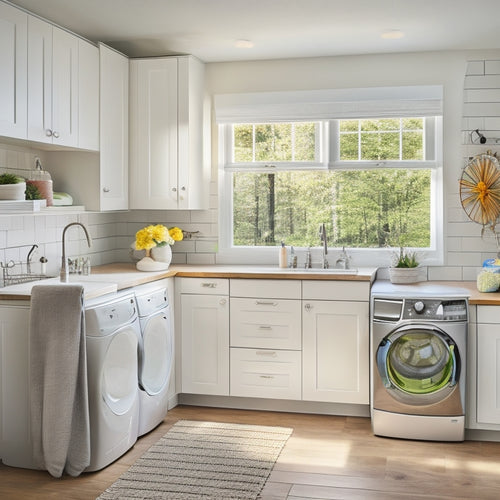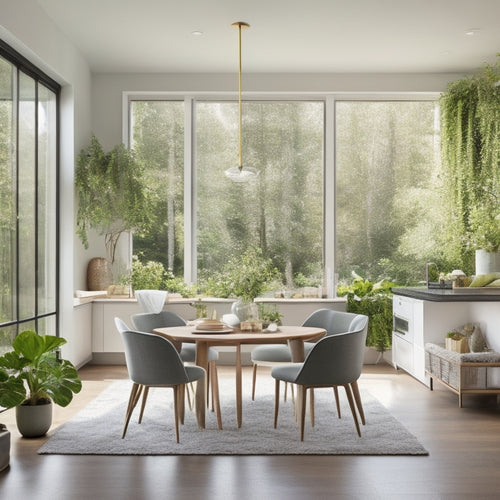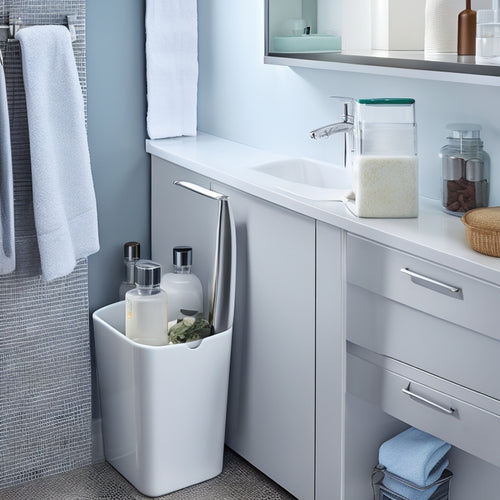
Streamline Your Kitchen With a Utensil Drawer System
Share
You'll find that a well-designed utensil drawer system can revolutionize your kitchen workflow by maximizing storage space and keeping essentials within easy reach. Start by purging duplicates, grouping similar items, and categorizing utensils into logical clusters. Utilize space-saving solutions like adjustable dividers and visually organize your storage spaces. Sort utensils into baking tools, cooking essentials, and serving pieces, and consider color-coding for a pop of visual appeal. By streamlining your kitchen with a utensil drawer system, you'll enjoy reduced clutter chaos and effortless access to your go-to tools - and that's just the beginning of your kitchen's transformation.
Key Takeaways
• Purge duplicates and group similar utensils together to maximize drawer space efficiency and reduce clutter.
• Choose space-saving solutions, such as adjustable dividers, to customize your utensil organizer and utilize storage spaces effectively.
• Categorize utensils into logical groups, like baking tools, cooking essentials, and serving pieces, to create a functional and accessible storage system.
• Measure your drawer accurately to ensure a perfect fit for your utensil organizer, considering width, depth, and height, as well as obstacles like drawer slide clearance.
• Implement a maintenance routine, including weekly tidying and a 'one in, one out' policy, to maintain a clutter-free and organized utensil drawer.
Maximizing Drawer Space Efficiency
To maximize drawer space efficiency, start by purging your utensil collection, getting rid of duplicates, and grouping similar items together. This will give you a clear picture of what you need to store and help you decide on the most effective storage layout.
Next, consider the height and width of your drawer and choose space-saving solutions that fit snugly. Drawer dividers can be a game-changer in keeping utensils organized and easy to find. You can use adjustable dividers to separate items into categories, such as baking, cooking, and serving utensils.
For utensil storage ideas, think vertically by using stackable trays or baskets to store items like lids, spatulas, or whisks. This will help you make the most of your drawer's vertical space.
Customizing Your Utensil Organizer
As you customize your utensil organizer, you'll want to start by categorizing your utensils into groups that make sense to you, such as baking tools, cooking essentials, and serving pieces.
This strategy will help you visualize how you'll use the storage spaces in your drawer. By doing so, you'll be able to optimize each space to meet your specific needs and workflow.
Utensil Categorization Strategy
You'll want to sort your utensils into categories that make sense to you, like baking tools, cooking essentials, and serving pieces, to create a customized organizer that streamlines your kitchen workflow.
This utensil categorization strategy is essential for effective utensil organization. Consider grouping similar items together, such as all your whisks or spatulas, to create functional clusters. You can also use color coding to differentiate between categories, like using blue dividers for baking tools and red for cooking essentials. This visual approach will help you quickly identify where each utensil belongs.
When categorizing utensils, think about how you use them in your kitchen. For instance, you may want to separate utensils used for prep work, like chopping and dicing, from those used for cooking, like stirring and flipping. By grouping utensils by function, you'll reduce clutter and make it easier to find what you need when you need it.
Optimize Storage Spaces
With your utensils categorized, it's time to customize your organizer by allocating specific storage spaces for each group, ensuring that frequently used items are easily accessible and less-used ones are tucked away efficiently. This is where you get to optimize storage spaces and create a seamless drawer organization system.
When allocating space, consider the frequency of use and the size of each utensil group. For instance, place your most-used items, like spatulas and whisks, in easy-to-reach zones, while less-used items, like pastry brushes, can be stored towards the back or in smaller compartments. This approach will simplify kitchen storage and make the most of your available space.
Incorporating space-saving solutions, such as dividers, inserts, or adjustable compartments, can help maintain a minimalist design concept. These features allow you to tailor your organizer to your specific needs, ensuring that every utensil has its designated spot.
Benefits of a Divided Drawer
As you design your utensil drawer system, you'll appreciate the benefits of a divided drawer.
You'll enjoy organized utensil storage, where each item has its designated spot, making it easy to find what you need at a glance.
With a divided drawer, you'll also experience an efficient layout and reduced clutter chaos, freeing up space and reducing stress in your kitchen.
Organized Utensil Storage
By incorporating a divided drawer into your utensil storage system, every cooking utensil has a designated home, making it easier to find what you need when you need it. This means you'll spend less time searching for that one specific spatula or whisk, and more time cooking up a storm.
With organized utensil storage, you'll enjoy:
-
Compact organization: Your utensils will be neatly tucked away, freeing up valuable counter space and reducing clutter.
-
Easy access: No more digging through a jumbled mess of utensils to find what you need – everything will be at your fingertips.
-
Sleek storage: A divided drawer keeps your utensils hidden from view, maintaining a clean and stylish kitchen aesthetic.
- Reduced stress: Knowing exactly where everything is will make cooking and meal prep a breeze, reducing stress and anxiety in the kitchen.
Efficient Drawer Layout
You'll take your well-arranged utensil storage to the next level by designing an efficient drawer layout that optimizes every inch of space and makes the most of your divided drawer.
A well-planned layout guarantees that every utensil has its designated spot, making it easy to find what you need when you need it. This, in turn, boosts kitchen efficiency by reducing the time spent searching for utensils.
To achieve this, consider the types of utensils you use most frequently and group them together in a logical manner. For instance, place your most-used cooking utensils, such as spatulas and whisks, in a convenient and accessible section.
Designate a separate area for less frequently used items, like special occasion serving utensils. By categorizing and prioritizing your utensils, you'll create a drawer organization system that streamlines your kitchen workflow.
With a thoughtful layout, you'll be able to quickly grab the utensil you need, allowing you to focus on cooking up a storm!
Reduced Clutter Chaos
Divide and conquer clutter chaos with a well-designed utensil drawer system that keeps utensils neatly separated, making it easy to spot what you need at a glance. You'll no longer have to dig through a jumbled mess to find the right spatula or whisk. With a divided drawer, you'll be able to locate the utensils you need quickly, saving you time and reducing frustration in the kitchen.
Here are just a few benefits you'll experience with a utensil drawer system:
-
Easy access: Utensils are organized and easy to reach, making cooking and prep work a breeze.
-
Less stress: Decluttering tools like a divided drawer help you stay calm and focused in the kitchen.
-
More free time: With utensils organized and easy to find, you'll have more time to focus on cooking and enjoying meals with family and friends.
- Improved workflow: Organizing chaos in your utensil drawer means you can cook more efficiently, getting meals on the table faster.
Essential Utensils to Store Together
Store your most frequently used utensils, such as a chef's knife, cutting board, and kitchen shears, together in a convenient and accessible location. By grouping these essentials, you'll save time and effort when prepping meals.
Consider utensil pairing suggestions, like storing your wooden spoons with your silicone spatulas, or your whisks with your measuring cups. This thoughtful organization will make your cooking routine more efficient.
When selecting storage container options, choose ones that fit your utensil combinations and drawer organization style. For example, a divided tray or a utensil organizer with separate compartments can keep your frequently used items tidy and within reach.
You can also use adhesive-backed hooks or a utensil holder attached to the side of your drawer to maximize vertical storage.
Designing for Easy Accessibility
To secure effortless retrieval, position your utensil drawer system in a convenient location, such as near a food prep area or adjacent to a cooking station. This strategic placement guarantees you can quickly grab the utensils you need, saving time and streamlining your workflow.
To further enhance easy access, consider the following design elements:
-
Adjustable dividers: Allow you to customize the layout to fit your specific utensil collection, securing each item has a designated spot.
-
Tiered storage: Enables you to store utensils of varying lengths, keeping them organized and preventing clutter from building up.
-
Soft-close drawers: Provide a smooth, quiet opening and closing experience, reducing noise and disruption in the kitchen.
- Ergonomic handles: Make it easy to open and close the drawer, even when your hands are full or slippery.
Utensil Drawer System Types
With your utensil drawer system's accessibility and organization in place, you can now focus on choosing the right type of system that suits your kitchen's unique needs and style. You'll find a variety of utensil drawer system types to choose from, each offering its own set of benefits and features.
For a clutter-free look, consider a drawer organization system with dividers and compartments. This type of system keeps utensils separate and organized, making it easy to find what you need when you need it.
If you're short on space, look for space-saving ideas like stackable trays or adjustable dividers that maximize your drawer's real estate.
If style is a top priority, opt for a system with stylish utensil holders that add a touch of elegance to your kitchen. These holders can be customized to fit your kitchen's aesthetic, from modern and sleek to traditional and ornate.
Whatever your style, there's a utensil drawer system type that offers practical solutions to keep your kitchen organized and clutter-free. By choosing the right system, you'll be able to cook up a storm in a kitchen that's both functional and beautiful.
Measuring for a Perfect Fit
You'll need to take precise measurements of your utensil drawer to guarantee a seamless fit for your chosen system. This step is essential in achieving a customized drawer organization that maximizes efficient space.
A well-measured fit guarantees that your utensils and cookware are neatly stored, making your kitchen workflow more streamlined.
To take accurate measurements, follow these steps:
-
Width and depth: Measure the inside of your drawer, taking note of any obstructions like screws or hinges.
-
Height: Record the height of your drawer from top to bottom, including any adjustable dividers.
-
Obstacles: Identify any fixed elements, such as built-in dividers or electrical outlets, that may impact your system's design.
- Drawer slide clearance: Check the space between the drawer slides and the drawer itself to make sure your system fits snugly.
Installing Your Utensil Organizer
Now that you've selected your utensil organizer, it's time to put it into place, securing a snug fit by carefully positioning the components within your measured drawer space. Begin by laying out the individual parts, such as the utensil holder, dividers, and trays, to visualize how they'll fit together. This will help you identify any potential issues before you start installing.
As you start assembling the organizer, follow the manufacturer's instructions and take your time to guarantee each piece is securely attached. Use DIY tips like measuring twice and marking the drawer with a pencil to guide your installation. This will prevent mistakes and achieve a precise fit.
Once everything is in place, test the utensil holder and dividers to make sure they're functioning as intended. Make any necessary adjustments to achieve optimal drawer organization.
With your utensil organizer installed, you'll be amazed at how much space you've saved. The result will be a clutter-free drawer that's a joy to open, with all your utensils neatly stored and easily accessible.
Maintaining a Clutter-Free Drawer
Set a weekly reminder to tidy up your utensil drawer, ensuring that everything remains in its designated spot and preventing clutter from building up again. This habit will help you maintain a clutter-free drawer and keep your kitchen organized.
To keep your utensil drawer organized, follow these decluttering tips:
-
Remove any unnecessary items that don't belong in the drawer
-
Wipe down the drawer and utensil organizer with a damp cloth to remove crumbs and spills
-
Put back only the items that have a designated spot in the drawer
- Consider implementing a 'one in, one out' policy to prevent clutter from building up in the future
Related Posts
-

Revamp Your Laundry Room With Smart Space-Saving
You're tired of feeling cramped and disorganized in your laundry room, and it's time to revamp the space to make the ...
-

Family Harmony Achieved: Doral Home Renovation Unveiled
We designed our Doral home renovation around a simple yet powerful idea: that a unified, open space can bring our fam...
-

Revamp Your Under-Sink Setup Like a Pro
To revamp your under-sink setup like a pro, start by evaluating your space and categorizing existing items, taking no...


